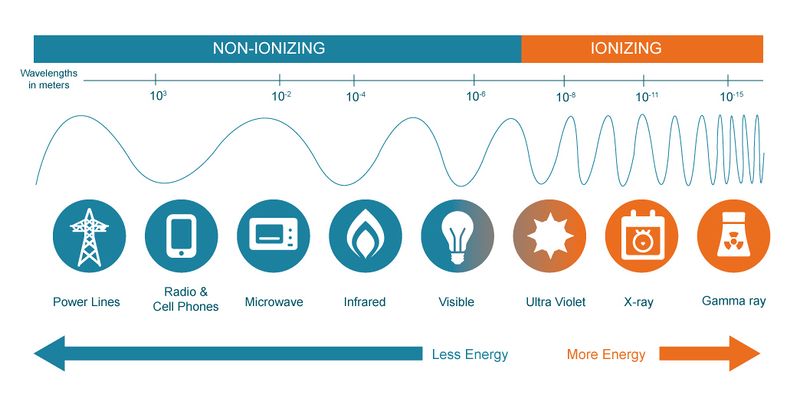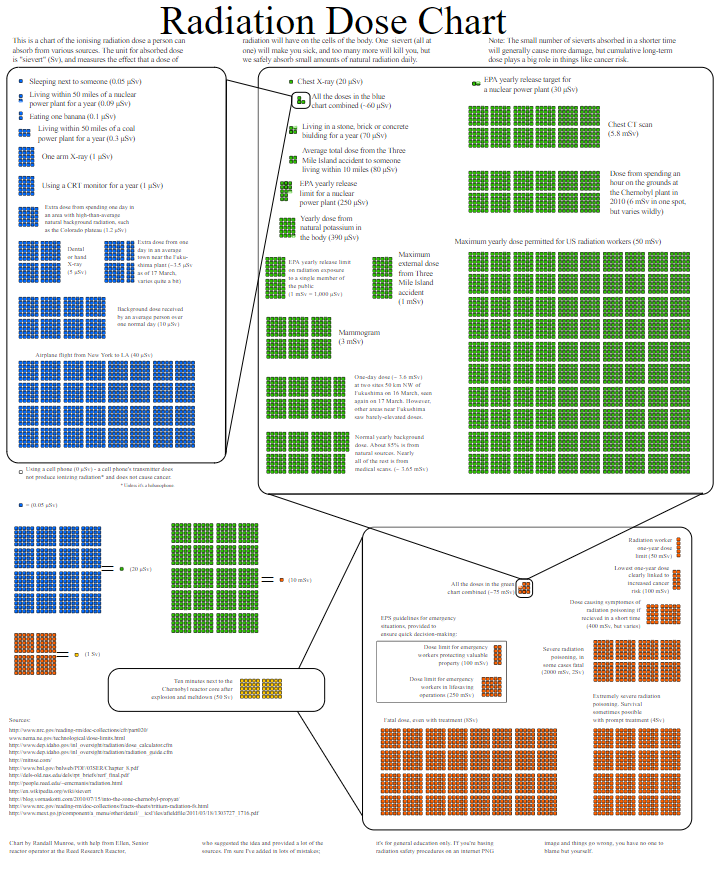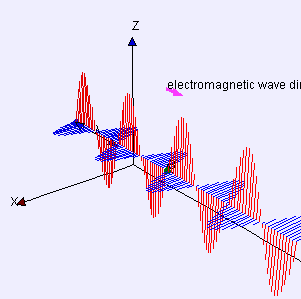First things first: Your cell phone can’t cause cancer.
The reason is the difference between non-ionizing and ionizing radiation.
When most people think of radiation, they think of cancer treatment, X-rays, or maybe even nuclear bombs. Radiation is all around us. Low amounts of radiation are in our buildings, microwaves, smart watches, the earth around us, and sun! A majority of it comes from natural sources.
A majority of this radiation is perfectly harmless.
Physicists define radiation as any transmission of energy through waves or particles called electromagnetic radiation (EM). Radio waves, cell phone communications, all wireless connectivity, laser pointers, and light are all “radiation” in the eyes of physics.
Radiation is everything that flies around giving out energy. Sometimes that energy just makes things hotter (microwaves). This is non-ionizing radiation and is not considered harmful. Sometimes that energy is so powerful it rips apart atoms and molecules, which damages human tissue and may cause cancer. This is called ionizing radiation and is the stuff of nuclear bombs. Normal processes in the body exist to lessen DNA and cell damage. But exposure to too much ionizing radiation will overwhelm the body’s defenses.
Let’s break the distinctions down:
| Ionizing (High Energy) Radiation | Non-Ionizing (Low Energy) Radiation | |
|---|---|---|
| How it Works | Remove electrons from atoms and molecules in materials (e.g. air, water, living tissues). | Does not remove electrons, but can heat things |
| Examples | X-Rays, CT Scans, Building Materials, Naturally Occurring Minerals | Microwave Ovens Radio Waves Cell Phones |
| Health Effects | Can damage DNA, cause skin and tissue damage, and possibly lead to cancer at high doses. | Can cause heat damage, Studies say it does not cause DNA damage or cancer |
The below image shows the distinction between non-ionizing and ionizing radiation and where common devices and products fall.

NOTE: Ultra-Violet radiation (from the sun) is right on the border between ionizing and non. This is why it is very important to wear a broad-spectrum sunscreen, as too much UV radiation can cause skin cancer.
Well what about all that heat? My microwave makes things hot? Is that ionizing?
Yes, your microwave makes things hot. This is done because the microwaves excite the water in the food, causing them to jiggle around, and heat things up.
The human body is made of lots water. Thus, don’t stick your head in the microwave or park yourself right in front of a high-powered radio dish. Doing this for a long period of time may cause a burn. But it will not cause underlying DNA damage. DNA damage is what leads to cancer.
How much ionizing radiation is harmful?
Whether a radiation exposure is harmful to your health depends on many factors:
- Dose, the amount you are exposed to
- Dose rate, how fast you are exposed (Ex. all at once or over a period of years)
- Who is exposed, certain groups of people are more sensitive to the effects of radiation (children, older adults, pregnant women, people with weakened immune systems).
Dose and dose rate explain why doctors leave the room during X-rays. One X-ray is not likely to be damaging to your health. If a doctor is exposed all day, every day, over a period of years, her/his health would be more likely to be negatively impacted.
The Banana Equivalent Dose
Ionizing radiation is measured in many different units depending on what type or what is being measured (energy, radiation rate, dose). Dose measures the amount of energy absorbed by your body and is commonly measured in sieverts (Sv).
All of these units are hard to imagine or interpret. But, as we learned, ionizing radiation occurs naturally, including in bananas (via potassium). Thus, every banana you eat has some radiation in it. Please don’t stop eating potassium, you need it. And unless you eat over 200 million bananas in a day, you are going to be just fine.
Daily you are exposed to the equivalent of 100 bananas, a flight from NY to LA is 400 bananas, a chest CT Scan is 58,000 bananas, and a lethal dose is between 200 Million and 800 Million bananas. For perspective, the average person living within 10 miles of the Three Mile Island Accident received 800 bananas (or a round trip between NY and LA on a plane). The Chernobyl Accident delivered 5 BILLION bananas in the first 10 minutes.

The chart above and some outtakes below are all found in this cool chart.
| Item | Dose |
|---|---|
| 1 Banana | 0.000,000,1 Sv |
| 1 arm X-Ray | 0.000,001 Sv |
| Daily background does from living | 0.000,010 Sv |
| Airplane flight from New York to Los Angeles | 0.000,040 Sv |
| 1 year effect — living within 10 miles of the Three Mile Incident | 0.000,080 Sv |
| Chest CT Scan | 0.005,8 Sv |
| 1 year dose limit for a radiation worker | 0.050 Sv |
| 1 year does linked to potentially causing cancer | 0.100 Sv |
| Severe Radiation Poisoning | 2.0 Sv |
How to Protect Yourself
Most radiation we are exposed in our daily lives are low doses, over long periods of time, or both, which reduce the risk of harm. Then what about an (exceedingly rare) radiation emergency such as a nuclear disaster? These disasters are the ones that make radiation such a scary topic that feels out of control, but there are still things you can do to protect yourself in a radiation emergency.
Much like stop, drop, and roll, radiation disasters have a catchy saying too: Get Inside, Stay Inside, Stay Tuned.

- Get Inside—the walls of a home or building can block some radiation. The best place to shelter is inside low and in the middle, meaning away from walls and windows and in a basement or bottom floor.
- Stay Inside—staying inside for at least 24 hours protects you until evacuation is safe. While inside, you can take steps to limit your exposure through indoor air and food and water.
- Stay Tuned—because you will need to stay inside for a while, it’s important to have access to information from emergency workers. Make sure you have an emergency kit at home that allows you to access radio or internet (if internet is available in the emergency).
For more information on radiation in your everyday life or protecting yourself during a radiation emergency, visit https://www.cdc.gov/nceh/radiation/default.htm.
BONUS why is it called Electromagnetic (EM) Radiation and what is an EM Spectrum?
As we saw above electromagnetic (EM) radiation travels around at varying levels of energy.
Energy travels in discrete packets called photons. Even though photons carry no charge, they create an oscillating electric field (electricity is wild!!) and this, in turn, creates a magnetic field. As the photon moves, it travels in a wave of alternating electric and magnetic fields; hence, electro-magnetic radiation. This is what light is made of. Little packets of electromagnetic oscillation flying around carrying information is how we humans are able to see!
Think about waves at the beach, if the peaks are close together (the distance between peaks is called the wavelength) the water is rougher. For a traveling EM wave – if the peaks are closer the energy is higher. Smaller wavelength EM radiation is more energetic and can cause more damage. Just like how rough water is less pleasant to swim in because it knocks you around more.
Since the radiation energy and properties very depending on the wavelength, physicists say it is located on a “spectrum” which is anything that rests on a scale with a defined minimum and maximum. The speedometer on a car is a spectrum. With 0 miles per hour being the minimum and somewhere above 100 as the maximum. The car’s speed is always on the spectrum as defined by the speedometer.
Sources
http://www.nrc.gov/reading-rm/doc-collections/cfr/part020/
http://www.nrc.gov/reading-rm/doc-collections/fact-sheets/tritium-radiation-fs.html
http://www.nema.ne.gov/technological/dose-limits.html
http://www.deq.idaho.gov/inl_oversight/radiation/dose_calculator.cfm
http://www.deq.idaho.gov/inl_oversight/radiation/radiation_guide.cfm
http://blog.vornaskotti.com/2010/07/15/into-the-zone-chernobyl-pripyat/
http://dels-old.nas.edu/dels/rpt_briefs/rerf_final.pdf
http://en.wikipedia.org/wiki/Sievert
http://radiology.rsna.org/content/248/1/254
http://chottomatte.net/2011/03/16/tokyo-radiation-levels-daily-updates/


